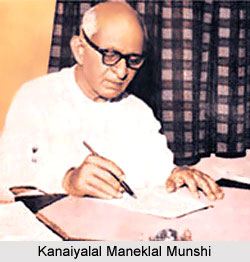 Kanhaiyalal Maneklal Munshi was born on December 30, 1887 at Bharuch in Gujarat.He received his education from Baroda college. Kanhaiyalal Maneklal Munshi obtained a degree in law and started practising in Bombay High Court. When he was a student his teacher Sri Aurobindo Ghosh immensely inspired him. Kanhaiyalal Maneklal Munshi, the Indian freedom fighter entered into politics as the member of the Subjects Committee of the Indian National Congress. Later he became the member of Swaraj Party.He also joined the Home Rule League. He was the Joint Editor of Young India. At that time Kanhaiyalal Maneklal Munshi was the member of Bombay Legislative Council.
Kanhaiyalal Maneklal Munshi was born on December 30, 1887 at Bharuch in Gujarat.He received his education from Baroda college. Kanhaiyalal Maneklal Munshi obtained a degree in law and started practising in Bombay High Court. When he was a student his teacher Sri Aurobindo Ghosh immensely inspired him. Kanhaiyalal Maneklal Munshi, the Indian freedom fighter entered into politics as the member of the Subjects Committee of the Indian National Congress. Later he became the member of Swaraj Party.He also joined the Home Rule League. He was the Joint Editor of Young India. At that time Kanhaiyalal Maneklal Munshi was the member of Bombay Legislative Council.
Kanaiyalal Maneklal Munshi was a great Gujarati scholar. He was an advocate by profession. He worked in the freedom struggle, edited Young India for a brief period, and helped Sardar Patel in the unification of princely states, later becoming Governor of Uttar Pradesh. He established Bharatiya Vidya Bhavan, the reputed organization for research and education in Indian culture. This organization`s still-active theatre wing helped launch the `new` Gujarati theatre in the early 1930s. The Gujarati scholar was also a major novelist.
He contributed decisively to drama both by writing and supporting productions. Theatre-loving friends like C. C. Mehta accompanied this action and the time was in the 1920s and 1930s. A box set was built for his play Kakani Shashi i.e. `Uncle`s Shashi` in 1929, discarding painted curtains for the first time, in a production by the Bhavan. Putra Samovadi i.e. "Daughter like Son" in 1929 was another important drama.
The eminent Gujarati scholar, Kanaiyalal Maneklal Munshi wrote comedies too. The range includes Vavasbethnu sivatantrya i.e. Merchant Vava`s Independence in 1921, Be Kharab Jan or "Two Wicked Persons" in 1924, filmed by Chimanlal Luhar in 1936, Brahmacharyashram i.e. "Celibacy Ashram" in 1931. Another segment was mythological drama like Purandarparajay or "Purandar`s Defeat" in 1922 and Lopamudra 1933. During the 1930s, there was not a single college festival in Gujarat without a performance of one of his plays. Their characterization, dramatic dialogue, subtle comic sense, structure, and design always challenged directors and actors and made him popular with all sections of the audience. The Gujarati scholar, Kanaiyalal Maneklal Munshi exposed vanity and hypocrisy in farces like Chhiye Tej Thik or "Let`s Be What We Are" in 1948 and Vah re men vah i.e. "Bravo, Myself" in 1949. He also wrote screenplays such as Dr Madhurika in 1935 and non-fiction in English.
Kanhaiyalal Maneklal Munshi was one of the prominent figures of Gujarati Literature too. He was associated with a monthly magazine BHARGAVA.He wrote 125 books in English, Hindi & Gujarati including novels, short stories, biographies and autobiography. Kanhaiyalal Maneklal Munshi`s major works in Literature are "Mari Kamala`, `Vern Vasulat`, `Kono-Vank`, `Patan-ni-Prabhuta`, `Gujarat-no-Nath`, `Prithvi Vallabh`, `Rajadhi Raj`, `Kakani Shashi`, `Gujarat & Its Literature`, `I Follow the Mahatma`, `Akhand Hindustan`, `The Glory that was Gurjaradesa`, `Imperial Gurjars`, `Bhagvadgita & Modern Life`, `Gandhi the Master`, `The End of an Era`, `Krishnavatara`.
During the Salt Satyagraha in 1930, this well-known Indian freedom fighter, Kanhaiyalal Maneklal Munshi rejoined Indian National Congress. For his involvement on this Satyagraha, the British rulers imprisoned Kanhaiyalal Maneklal Munshi. In 1932, he was again imprisoned in Bijapur for two years. On his release he again became the member of Bombay Legislative Assembly and served as the Home Minister in the first Congress Government in 1934. Kanhaiyalal Maneklal Munshi was again arrested for his active participation in the Quit India Movement of 1942.He was a great educationalist and contributed a lot to disseminate the education. He was the President of the Panchgani Education Society. Kanhaiyalal Maneklal Munshi established the Gujarati Sahitya Sansad. He held different posts in the Bombay University. Maharaja Kanhaiyalal Maneklal MunshiGaekwad of Baroda appointed him as a Member of the Baroda University Commission. In 1938, Kanhaiyalal Maneklal Munshi, the great Indian freedom fighter set up the prestigious Bhartiya Vidya Bhavan institution at Bombay, and served as the President of this institution till his death.
In 1946 Kanhaiyalal Maneklal Munshi was selected as the member of the Experts` Committee of the constituent assembly of India and played a major role in drafting the constitution of India. He was also the member of Flag Committee, which selected the Flag of India, 1947. Kanhaiyalal Maneklal Munshi served as the Agent-General to the Government of India in princely state Hyderabad. In 1952 he was appointed as the Minister for Food & Agriculture in Nehru`s cabinet. During this tenure Kanhaiyalal Maneklal Munshi introduced Vanmahotsav (tree plantation) and tried his best to enlarge the area of forest in India. From 1952 to 1957 he served as the Governor of Uttar Pradesh.. After that he left the Congress party and formed Swatantrata Party along with Chakravarti Rajgopalachari.He served as the vice prisedent of this party. Later he joined Jan Sangh.
Kanhaiyalal Maneklal Munshi breathed his last on February 8, 1971.




















